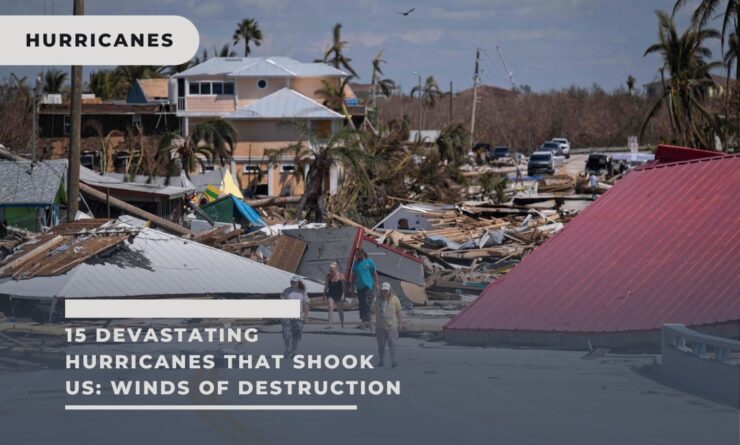The annual hurricane season has started again, and the National Oceanic and Atmospheric Administration has predicted up to nine hurricanes this year, with between one to four potentially developing into major hurricanes. Global warming is exacerbating the problem, causing more rainfall and more forceful winds.
One such example is Hurricane Ian, a Category 5 storm, which devastated southwest Florida the previous year with winds reaching 150 mph. It resulted in the death of 150 individuals and billions of dollars in damages.
Below are some of the most destructive and fatal hurricanes that have impacted the United States
| Category | Wind Speed (mph) | Deaths | Property Damage ($) | |
|---|---|---|---|---|
| Donna (August 1960) | Category 4 | 130-156 | 114 | $387 million |
| Agnes (June 1972) | Category 1 | 74-95 | 122 | $2.1 billion |
| Ian (September 2022) | Category 4 | 130-156 | 150 | $112 billion |
| Sandy (October 2012) | Category 2 | 96-110 | 233 | $50 billion |
| Camille (August 1969) | Category 5 | 157+ | 256 | $1.4 billion |
| Audrey (June 1957) | Category 4 | 130-156 | 390 | $150 million |
| Great Atlantic (September 1944) | Category 3 | 112-129 | 390 | $100 million |
| Florida Keys Labor Day (August 1935) | Category 5 | 157+ | 408 | $6 million |
| New England (September 1938) | Category 3 | 112-129 | 600 | $308 million |
| Sea Island (August 1893) | Category 3 | 120 | 1,000 | $1 million |
| Cheniere Caminada (October 1893) | Category 5 | 130 | 1,100 | $5 million |
| Katrina (September 2005) | Category 4 | 157+ | 1,207 | $75 billion |
| San Felipe-Okeechobee (September 1928) | Category 4 | 130-156 | 2,166 | $75 million |
| Maria (September 2017) | Category 4 | 150 | 2,975 | $90 billion |
| Galveston (August 1900) | Category 4 | 130-156 | 8,000 | $30 million |
15. Hurricane Donna (August 1960)
- Category 4: 130-156 mph wind speeds
- Fatalities: 114
- Property damage: $387 million
Regarded as the fifth most powerful hurricane to strike the U.S., Donna is the only hurricane known to have caused hurricane-force winds in Florida, the Mid-Atlantic, and New England during a single event, as stated by the NOAA.
Beginning near Cape Verde on the western coast of Africa, Donna traveled northwest for five days across the Atlantic Ocean, then hit the Leeward Islands with its full force.
It then proceeded north to Puerto Rico, causing the deaths of over 100 people, before touching down in the Florida Keys. As it moved along its path, Donna ravaged parts of eastern North Carolina, Long Island in New York, and Block Island in Rhode Island.
14. Hurricane Agnes (June 1972)
- Category 1: 74-95 mph wind speeds
- Deaths: 122
- Property damage: $2.1 billion
Agnes originated in Mexico’s Yucatan Peninsula, moved east into the Caribbean Sea, then took a northern course to the Gulf of Mexico. It made landfall in the Florida Panhandle and Georgia. It caused extensive flooding as it plowed through eastern North Carolina and concluded its trail of destruction in New York City.
13. Ian (September 2022)
- Category 4: 130-156 mph wind speeds
- Deaths: 150
- Property damage: $112 billion
Ian is noted by the NOAA as Florida’s most expensive hurricane and the third costliest in U.S. history in terms of property damage. It started off the western coast of Africa and gained strength as it traveled across the Atlantic for six days.
It then turned north in the Caribbean Sea, impacting Cuba and the Gulf of Mexico. Ian made landfall in Cayo Costa, Florida, and caused widespread devastation across the Carolinas. Over 100 Floridians lost their lives due to Ian.
12. Hurricane Sandy (October 2012)
- Category 2: 96-110 mph wind speeds
- Deaths: 233,
- Property damage: $50 billion
Sandy originated in the Caribbean Sea, then intensified as it moved northward across Jamaica, Cuba, and the Bahamas.
It then turned northeast and made landfall near Atlantic City, New Jersey. Sandy, which stretched over 900 miles at one point, impacted 24 states.
The hurricane caused a storm surge that flooded streets and the subway system in New York City, leading to widespread power outages. The resulting floods, high winds, and mudslides caused long-term impacts for many families.
11. Camille (August 1969)
- Category 5: 157 mph+ wind speeds
- Deaths: 256
- Property damage: $1.4 billion
Camille formed just west of the Cayman Islands in the Caribbean. It moved west, impacted parts of Cuba, then headed north towards the Gulf of Mexico and made landfall on the Mississippi coast.
The storm reached nearly 27 inches in barometric pressure in Mississippi, making it the second most intense hurricane in U.S. history.
Most of Camille’s devastation took place as it moved further west through Tennessee, Kentucky, West Virginia, and Virginia. While passing over the Virginias, it dumped as much as 20 inches of rain in some areas, causing flash floods.
10. Audrey (June 1957)
- Category 4: 130-156 mph wind speeds
- Deaths: 390
- Property damage: $150 million
Audrey originated in the Gulf of Mexico, moved north and made landfall at the border of Texas and Louisiana. Audrey created a storm surge of 8 to 12 feet in the southwest part of Louisiana during its brief journey through the state.
The hurricane’s most significant damage occurred after it moved inland, bringing heavy rain and strong winds to northern Mississippi and the Great Lakes region, causing the deaths of hundreds of people along the way.
9. Great Atlantic (September 1944)
- Category 3: 112-129 mph wind speeds
- Deaths: 390
- Property damage: $100 million
This hurricane began directly northeast of the Leeward Islands in the Caribbean Sea. It traveled northwest and hit landfall in Cape Hatteras, North Carolina.
Continuing its destructive path north, it devastated parts of Long Island, New York, and Point Judith, Rhode Island, and dropped nearly a foot of rain on cities like Hartford, Connecticut.
According to NOAA, 46 people died on land from the Great Atlantic Hurricane, and another 344 were killed while on five ships, including a U.S. Navy destroyer.
8. Florida Keys Labor Day Hurricane (August 1935)
- Category 5: 157 mph+ wind speed
- Deaths: 408
- Property damage: $6 million
This hurricane began in the central Bahamas, moved west, and gained strength after moving across Andros Island. It then continued northwest and battered the Florida Keys, causing most of its damage and killing hundreds of World War I veterans.
The storm weakened as it traveled up Florida’s west coast, downgrading to a Category 2 when it hit Cedar Key. The hurricane eventually reached Norfolk, Virginia, and then dispersed over the Atlantic Ocean.
7. New England (September 1938)
- Category 3: 112-129 mph wind speeds
- Deaths: 600
- Property damage: $308 million
This hurricane, often referred to as the “Long Island Express,” caused extensive damage in the northeastern United States. It started in the Atlantic, intensified as it moved west and struck Puerto Rico, possibly as a Category 5 hurricane, according to NOAA.
The storm then headed north and made landfall in Cape Hatteras, North Carolina. As it continued northward, it was downgraded to a Category 3 once it reached Long Island, New York, and parts of Connecticut. Heavy rainfall caused flooding of the Connecticut River and surges in Narragansett Bay and Buzzards Bay.
6. Sea Island Hurricane (August 1893)
- Category 3: 120 mph wind speeds
- Deaths: 1,000
- Property damage: $1 million
The Sea Island Hurricane developed in the Atlantic Ocean, gaining strength as it moved west towards the Caribbean Sea near the Lesser Antilles islands.
It then moved north through the Bahamas, bringing strong winds across the Sea Islands, a group of islands along Florida, Georgia, and South Carolina. The Sea Island Hurricane moved up the Atlantic coast and eventually made landfall in Savannah, Georgia.
The Sea Island hurricane was one of the most catastrophic storms in South Carolina’s history, contributing to an economic downturn in Beaufort County.
5. Cheniere Caminada (October 1893)
- Category 5: 130 mph wind speeds
- Deaths: 1,100
- Property damage: $5 million
Cheniere Caminada formed in the Caribbean Sea, moved northwest toward the Gulf of Mexico, then hit landfall in Cheniere Caminada, Louisiana — a fishing village east of Grand Isle.
The hurricane continued west and hit Mississippi, ravaging 500 miles of coastline between the two states. It also caused damage in Georgia and the Carolinas.
In total, Cheniere Caminada damaged ships and demolished parts of towns and crops. It was the second deadliest storm in Louisiana history, after Katrina.
4. Katrina (September 2005)
- Category 4: 157 mph+ wind speeds
- Deaths: 1,207
- Property damage: $75 billion
Weather specialists consider Katrina the most expensive hurricane in U.S. history, devastating New Orleans, the Mississippi coast, Alabama, and parts of Miami-Dade and Broward counties in Florida.
The hurricane originated in the Caribbean Sea southeast of the Bahamas, then moved northwest to Florida, making landfall in Broward County.
It turned west, intensified as it traversed the Gulf of Mexico, and returned to landfall at 125 miles per hour in Buras, Louisiana. Katrina generated about 10 to 14 inches of rain over Florida and 8 to 12 inches of rain along the northern Gulf coast. It also spawned 33 tornadoes, according to NOAA.
3. San Felipe-Okeechobee (September 1928)
- Category 4: 130-156 mph wind speeds
- Deaths: 2,166
- Property Damage: $75 million
The San Felipe-Okeechobee is widely regarded as one of the most destructive hurricanes in history. This storm began over the Atlantic, gathered strength while crossing the Leeward Islands, and then hit Puerto Rico.
From there, it journeyed northwest through the Bahamas, gaining even more strength, and made landfall in Palm Beach, Florida. The worst damage took place in Lake Okeechobee, Florida, where it caused storm surges of up to 9 feet. The hurricane eventually dissipated after barreling through eastern North Carolina and parts of the Great Lakes region.
2. Maria (September 2017)
- Category 4: 150 mph wind speeds
- Deaths: 2,975
- Property Damage: $90 billion
Maria started in the Indian Ocean and moved westward across the Atlantic Ocean, gaining momentum along the way. Its first landfall was on the Caribbean island of Dominica, where it dropped 23 inches of rain.
Maria then turned north and hit Puerto Rico, causing widespread destruction, including long-lasting power outages. Experts estimate that over 1,000 people in Puerto Rico were killed as a result of the storm, according to a 2017 New York Times report.
The hurricane continued north along the Atlantic Ocean shoreline, hitting Cape Hatteras, North Carolina. It eventually traveled further north to Cape Race, Newfoundland, before dissipating in the Atlantic.
1. Galveston (August 1900)
- Category 4: 130-156 mph wind speeds
- Deaths: 8,000
- Property damage: $30 million
The Galveston Hurricane was the deadliest weather disaster in U.S. history, according to NOAA. The storm system formed over the Atlantic, and journeyed to the Gulf of Mexico, gaining power along the way.
It made landfall in Texas, just south of Galveston. Its energy swept across the Great Plains, then weakened as it moved northeastward through the Great Lakes, New England, and southern Canada.
FAQ
What is a hurricane and how does it form?
A hurricane is a type of storm called a tropical cyclone, which forms over tropical or subtropical waters. These storms are characterized by a low-pressure center, strong winds, and heavy rain.
They form when a weather disturbance, such as a tropical wave, is met with warm water, moist air, and converging equatorial winds. These conditions can lead to the formation of a hurricane when the wind speed reaches 74 mph.
What are the categories of hurricanes and what do they mean?
Hurricanes are categorized based on their wind speed using the Saffir-Simpson Hurricane Wind Scale. The categories are as follows:
-
- Category 1: Winds 74-95 mph (Minor damage)
- Category 2: Winds 96-110 mph (Moderate damage)
- Category 3: Winds 111-129 mph (Major damage)
- Category 4: Winds 130-156 mph (Severe damage)
- Category 5: Winds 157 mph or higher (Catastrophic damage)
What is the impact of global warming on hurricanes?
Global warming can exacerbate the intensity of hurricanes. As the planet warms, sea surface temperatures rise, providing more energy for hurricanes. This can lead to storms with stronger winds and heavier rainfall.
For example, Ian, a Category 5 storm, devastated southwest Florida with winds reaching 150 mph, resulting in the death of 150 individuals and billions of dollars in damages.
What were some of the most destructive hurricanes in U.S. history?
Some of the most destructive hurricanes in U.S. history include Katrina, Maria, and the Galveston of 1900. These storms caused significant loss of life and billions of dollars in damage. For instance, Katrina, a Category 4 storm, resulted in 1,207 deaths and $75 billion in property damage.
How can communities prepare for hurricanes?
Communities can prepare for hurricanes by creating an emergency plan, building an emergency supply kit, and staying informed about the hurricane’s path and intensity. It’s also important to know your area’s risk of flooding and to prepare your home accordingly.
This can include installing hurricane shutters or pre-cut plywood for windows and ensuring that gutters are clear and the roof is in good condition.
What is the role of the National Oceanic and Atmospheric Administration (NOAA) in hurricane tracking and prediction?
The NOAA plays a crucial role in hurricane tracking and prediction. Their National Hurricane Center monitors tropical storm systems, issues warnings to affected areas, and provides accurate forecasts of a hurricane’s path and intensity.
This information is vital for emergency management officials and the public to make informed decisions about evacuations and other safety measures.
Conclusion
In conclusion, hurricanes are powerful and destructive forces of nature that have caused significant loss of life and property damage throughout U.S. history.
The impact of these storms is exacerbated by global warming, which leads to higher sea surface temperatures and, consequently, more intense hurricanes.
Some of the most destructive hurricanes in U.S. history, such as Katrina, Maria, and the Galveston Hurricane of 1900, serve as stark reminders of the devastating potential of these storms.












